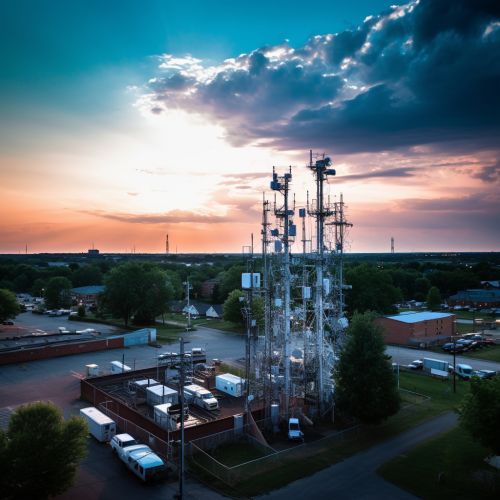Mobile Network Operator
Overview
A Mobile Network Operator (MNO) is a telecommunications service provider that owns or controls all the necessary components to sell and deliver services to its customers. These components include the radio spectrum allocation, wireless network infrastructure, backhaul infrastructure, billing systems, customer care services, and marketing and sales operations.
History
The concept of mobile telephony began in the early 20th century, but it wasn't until the 1980s that the first generation (1G) of mobile networks was introduced. These networks, such as the Advanced Mobile Phone System (AMPS) in the United States and the Nordic Mobile Telephone (NMT) system in Scandinavia, were analog and primarily designed for voice communication.
The second generation (2G) of mobile networks, introduced in the 1990s, marked the transition from analog to digital communication. The most common 2G technology, Global System for Mobile Communications (GSM), introduced data services such as Short Message Service (SMS) and Multimedia Messaging Service (MMS).
The third generation (3G) of mobile networks, introduced in the 2000s, brought about a significant increase in data transmission rates, enabling services such as mobile internet access and video calling. The most common 3G technology is Universal Mobile Telecommunications System (UMTS).
The fourth generation (4G) of mobile networks, introduced in the 2010s, provides even higher data transmission rates, improved quality of service, and reduced latency. The most common 4G technology is Long Term Evolution (LTE).
The fifth generation (5G) of mobile networks, currently being deployed, promises even higher data transmission rates, lower latency, and the ability to connect a vast number of devices, paving the way for the Internet of Things (IoT).


Components of a Mobile Network Operator
A Mobile Network Operator consists of several key components, each playing a crucial role in the delivery of services to customers.
Radio Spectrum Allocation
The radio spectrum is a part of the electromagnetic spectrum used in wireless communication. MNOs must obtain licenses to use specific bands of the spectrum from the national regulatory authority, such as the Federal Communications Commission (FCC) in the United States.
Wireless Network Infrastructure
The wireless network infrastructure includes all the hardware and software necessary to provide wireless services. This includes cell towers, base stations, mobile switching centers, and the radio access network.
Backhaul Infrastructure
The backhaul infrastructure connects the wireless network infrastructure to the core network and the internet. It can consist of wired connections (such as fiber optic cables) or wireless connections (such as microwave links).
Billing Systems
Billing systems are responsible for tracking the usage of services by customers, generating bills, and managing payments.
Customer Care Services
Customer care services handle customer inquiries, complaints, and requests for service. This can include call centers, online support systems, and retail stores.
Marketing and Sales Operations
Marketing and sales operations are responsible for promoting the MNO's services and acquiring new customers. This can include advertising campaigns, sales teams, and partnerships with device manufacturers and retailers.
Types of Mobile Network Operators
There are several types of mobile network operators, each with its own business model and level of infrastructure ownership.
Full MNOs
Full MNOs, also known as traditional or legacy MNOs, own and operate their own wireless network infrastructure. They have full control over their services and are responsible for all aspects of their business, from network operation to customer care.
Mobile Virtual Network Operators (MVNOs)
Mobile Virtual Network Operators (MVNOs) do not own their own wireless network infrastructure. Instead, they lease capacity from a full MNO and resell it to their customers under their own brand. MVNOs typically focus on specific market segments or offer unique services to differentiate themselves from full MNOs.
Light MNOs
Light MNOs, also known as network-light operators, own some of their own infrastructure but also lease capacity from a full MNO. This allows them to have more control over their services than MVNOs but with less capital investment than full MNOs.
Regulation
Mobile Network Operators are subject to regulation by national regulatory authorities. These regulations can cover a wide range of areas, including spectrum licensing, network neutrality, consumer protection, and competition law.
Future Trends
The mobile network industry is constantly evolving, driven by technological advancements and changing consumer demands. Some of the key trends shaping the future of the industry include the deployment of 5G networks, the rise of the Internet of Things, and the increasing importance of data and analytics.
